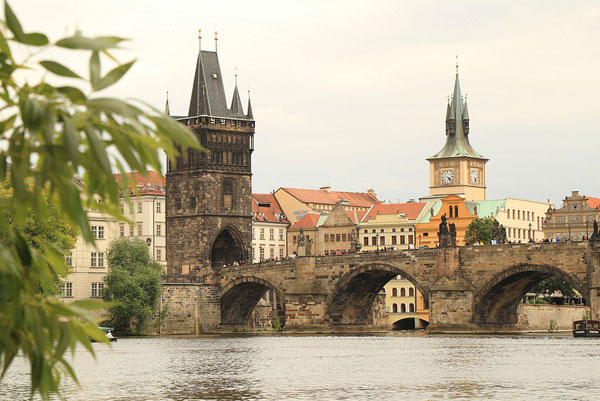
It’s hard to imagine that a beautiful city like this often suffers from floods in the summer. During the big flood of August, 2002, more than half of the subway stations were shut down, the number of tourists dropped by 50%, and many buildings were damaged. It is said that the name of the Vltava River is composed of “vlt” (meaning “wild”) and “Va” (meaning “water”). The Vltava River caused considerable destruction even in ancient times, but its unruliness is totally imperceptible when it’s quiet. Despite many natural disasters and ravages of wars and revolutions, Prague is ever full of historical richness and shows no sign of human damage.
In 1355, Charles the Fourth made Prague the capital of the Holy Roman Empire, just like Rome in the north. An interesting coincidence is that, both Prague and Rome were built on seven hills and both have a river flowing through the city from south to north. Standing in Prague Castle looking down on thousands of red tile roofs and buildings, one cannot help but feel moved seeing architecture spanning over more than ten centuries from ancient Rome to the Renaissance, in styles ranging from Baroque to Rococo. Walking in the city of Prague, students and admirers of architecture would feel like walking in a textbook. What can be learned in one visit in Prague far exceeds one year’s study in architecture.
Karlův most(Charles Bridge)
The correct name of the bridge is Charles Bridge, but somehow the Chinese translation named it “Charlie Bridge”. As a result, even “Charles the Fourth” was translated “Charlie the Fourth”. After all these years, the translation, though inaccurate, has been accepted through use.
There are bushels of stories about the Charles Bridge. One of the more interesting ones is about how architects in the past mixed eggs in the cement to make the bridge stronger. (This reminds me of women applying egg white on their faces to make the skin tighter.) People from all over Bohemia were mobilized to deliver eggs to Prague. A village thought of a “smart” way to keep a whole caravan of eggs from breaking during transit by boiling them first! Testing done during later repairs of the bridge foundation did reveal egg in its content, but a recent test showed that there were at most only 80 eggs. Perhaps it’s from the bridge builders’ lunches that accidentally fell into the cement mixture. After all, it took almost 2 centuries to finish building the bridge, and it’s hard not to have foreign substances accidently mixed in.
Another story is that the astrologer of Charles the Fourth suggested to have the bridge construction begin at 5:31AM, July 9th, 1357 (1357/9/7, 5:31) . Did you notice that 1357-9-7-5-31 is a string of odd numbers increasing from 1 to 9 and decreasing back to1. From what I know about astrology, odd numbers are positive, electricity, while even numbers are negative, magnetism. I wonder if this concept had anything to do with the bridge construction. The point is, whether in Europe or China or elsewhere in the world, kings and emperors of ancient times were all very superstitious.
Charles Bridge is beautiful, but, like the Great Wall of China, every corner of the bridge is packed by tourists. When you go on the bridge at any time other than early morning and late night, there is a sea of people. The first time I managed to squeeze into a wall of people to go on the bridge, I was in no mood to appreciate it. It wasn’t until I was able to see the bridge from a distance that I truly saw its splendors.
|